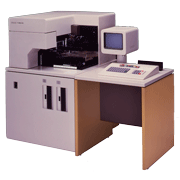Hitachi developed the HITAC T-550/30 OCR system as a full-fledged distributed OCR reader that would allow anyone to create clean data in order to reduce the labor associated with data entry, which was the largest bottleneck in information processing. The system came with rich data check functionality to increase data reliability and correction functions, in addition to high recognition performance capable of reading handwritten katakana characters inexpensively. It also eased the format limitations on forms so the system could support a wide range of applications, and when the HITAC T-550/30 was combined with other terminal devices (the HITAC L-320 terminal computer and the H-1740 data entry system), users could construct highly efficient distributed processing systems. The system could be used offline with floppy disk output or online with a network connection to a host computer.
| Readable characters | OCR-B font (letters and numbers) Handwritten numbers, letters, katakana characters, and symbols |
|---|---|
| Readable forms | Length: 95 to 305 mm,Width: 60 to 265 mm,Thickness: 0.1 to 0.17 mm (paper weight between 70 and 123 kilograms),photocopied forms |
| Processing speeds | Maximum ~50 sheets per minute (when reading 10 handwritten characters on a 90 mm long form) |
| Paper feed control | Immediate correction mode, continuous reading and batch correction mode |
| Sales launch period | August 1977 |
Hitachi announced the T-550/40 and T-550/50 as the successors to the T-550/30 in August 1981. Later, the company announced higher end models, the T-550/60 in April 1982 and the T-550/80 in June 1983. In terms of performance, the T-550/40 could process up to about 50 sheets per minute (about 20 sheets per minute when reading 100 handwritten characters on A5 forms), the T-550/50 could process up to about 100 sheets per minute (about 33 sheets per minute when reading 100 handwritten characters on A5 forms), the T-550/60 could process up to about 100 sheets per minute (about 48 sheets per minute when reading 100 handwritten characters on A5 forms), and the T-550/80 could process up to about 240 sheets per minute (about 90 sheets per minute when reading 100 handwritten characters on A5 forms). The addition of these models strengthened Hitachi’s product line, allowing users to select the model that suited their data volume needs. The newer models used a graphic verification method, [*] a new character recognition technique that treated characters as graphic figures. Reading accuracies were improved with enhanced post-reading inspections and other techniques. Specifications on readable forms dropped the requirement for black reference marks or verification marks on forms, meaning that users could design and print forms in a single color used as the dropout color. Size limitations were eased significantly, accepting forms from A8 to A3, making it possible to read everything from small book slips to large coding sheets. Hitachi also developed a high-luminance lamp that made it possible to use ordinary black-color pens whether the dropout color was red or blue. The lamp could be installed on the T-550/60 and T-550/80 models.
※The graphic verification method determined the characteristics of each character and checked the consistency of these characteristics against graphics stored on the system in order to verify a recognition results. The previous non-linear matching method recognized characters by dividing the character into line segments and coding each line segment.


